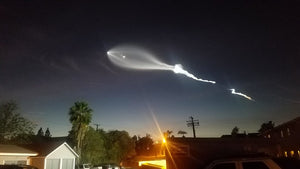April- Lyrid Meteor Shower, Whirlpool Galaxy and Leo Triplet
The Lyrid Meteor Shower
The Lyrid Meteor Shower Peaks this year April 22nd. The waning crescent moon this night gives us a great opportunity for some video. Here's some advice on how to view the Lyrid meteor shower and create a timelapse using a camera:
-
Find a dark location: The Lyrid meteor shower is best viewed away from city lights to minimize light pollution. Look for a dark location, such as a park or a remote area, where you can have a clear view of the sky.
-
Check the weather: Make sure to check the weather forecast for the night of the Lyrid meteor shower. Clear skies are ideal for meteor viewing, so choose a night with little to no cloud cover.
-
Arrive early and get set up: Arrive at your chosen location well before the peak of the meteor shower, which usually occurs in the early morning hours. Set up your camera on a tripod to ensure stable shots during the timelapse.
-
Use a wide-angle lens: A wide-angle lens is best for capturing a large portion of the sky and increasing your chances of capturing meteor streaks. A lens with a focal length between 14-24mm is recommended.
-
Use manual mode: Set your camera to manual mode so you have full control over the settings. Start with the following recommended settings: ISO 1600-3200, aperture f/2.8-f/4, and shutter speed of 15-30 seconds. Adjust the settings as needed based on the brightness of the meteors and the ambient light conditions.
-
Frame your shot: Choose a composition that includes an interesting foreground element, such as a tree, mountain, or silhouette, to add visual interest to your timelapse.
-
Start the timelapse: Set your camera to capture a series of images at regular intervals, typically every 10-30 seconds, depending on the duration of your timelapse. Use a remote shutter release or a timer function to avoid camera shake.
-
Be patient and watch the show: Meteor showers can be unpredictable, so be prepared to wait and be patient. Keep an eye on the sky and enjoy the natural spectacle as meteors streak across the night sky.
-
Process your timelapse: After capturing your timelapse, transfer the images to your computer and use timelapse software to stitch them together into a video. You can also enhance the video by adjusting the brightness, contrast, and color balance to bring out the best of the meteor streaks.
Remember to dress warmly, bring snacks and drinks, and be mindful of your surroundings while you're out in the dark.
Whirlpool Galaxy- M51
The Whirlpool Galaxy, also known as M51, is one of the most photographed galaxies in the night sky. It can be seen during spring and is popular among stargazers. French astronomer Charles Messier discovered it in 1773. Later, William Parsons noticed its spiral shape, which gave the galaxy its nickname.
The Whirlpool Galaxy has a brightness of magnitude 8.7. This means it’s visible with binoculars if you're under a dark sky, away from city lights. However, the best view comes through a telescope.
To find it, start with Alkaid, the bright star at the end of the Big Dipper’s handle. From there, move about two degrees southeast to the star 24 Canum Venaticorum. Then, go another two degrees southwest. M51 is located in that area, forming part of a flattened triangle.
If you look at M51 through a small telescope, it will appear as a fuzzy, round patch. But with a larger telescope—one with a 250mm aperture or more—you can see its spiral arms, which are what make the galaxy so beautiful. Also nearby is a smaller galaxy called NGC 5195. It’s interacting with M51, and the two galaxies are slowly pulling on each other with gravity.
M65, M66 and NGC 3628
The Leo Triplet is a small group of galaxies located in the constellation Leo. The two brightest members, M65 and M66, are easy to find with binoculars, especially under dark skies. They appear as faint, fuzzy patches of light. The third member, NGC 3628, is a bit trickier—it’s dimmer and requires a telescope to see clearly. All three galaxies are located close together in the sky, making them a popular target for amateur astronomers.
With a telescope and about 70x magnification, you can see all three galaxies in the same field of view. They look like stretched-out smudges—this shape is due to their spiral structure, but seeing details like spiral arms takes more power. A telescope with an aperture of 250mm (or about 10 inches) or larger will start to show structure, especially in M66, which has a slightly warped disk. NGC 3628 is edge-on from our point of view, so it appears as a thin streak of light with a dark dust lane cutting through it—this feature is sometimes visible in larger scopes under ideal conditions.
Catching all three in one view is a fun and rewarding challenge for stargazers, especially in spring when Leo is high in the night sky.







